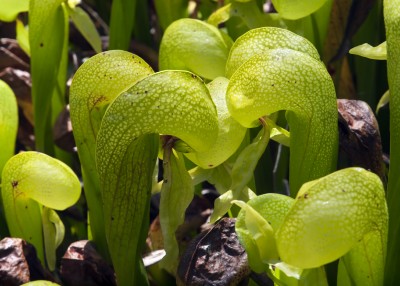






There is something otherworldly about the cobra lily plant. The undulating form and strangely built leaves call to mind old horror movies, yet give such a unique vision that the viewer is also reminded of the great diversity of life on our planet. This pitcher plant is not only unique in appearance but has an active appetite fed by insects and, occasionally, small vertebrates. If you are lucky enough to live in a zone sufficiently warm, learn how to grow cobra lily and bring this amazing plant’s drama into your landscape.
California pitcher plants (Darlingtonia californica) grow in distinctive groupings across the state’s countryside. Cobra lily pitcher plants are native to North America and found in nutrient poor boggy areas. The plants spread asexually through runners and stolens and infrequently flower. They are inimitable plants, unmatched by most flora in exceptional structure and eccentric beauty.
The cobra lily plant almost defies description. The main features of the plant are the modified leaves that rise from the base and terminate in hooded foliage. The leaves resemble the heads of cobras and they serve a specialized function. The habitat of these plants is poor in nutrients and they use those hooded leaves to gather fuel through digested insects.
The hood secretes an attractive scent, which entices unsuspecting prey to enter. Once inside, they have difficulty getting back out and the plant secretes digestive enzymes, which break down the animal matter. Unlike other pitcher plants, complete cobra lily information needs to include the fact that their hoods are not open and they do not collect rainwater to trap and drown their prey.
The cobra lily pitcher plants need warm temperatures, full sun and cold water to cool their roots. These conditions are hard to come by in all but a natural bog. However, if you can provide these circumstances, the plant may still be hard to come by. Darlingtonia pitchers are not as commercially available as Sarracenia pitcher plants.
If you do get lucky, a container garden is probably your best bet. Plant it in a high percentage of peat with just a little fine bark and garden sand. Flush the roots daily with fresh water and move it to shelter if temperatures are higher than 100 degrees Fahrenheit (37 C.). The ideal temperature range is 70 to 80 F. (21-26 C.) and they are hardy in USDA zones 7 to 10.
If you get a hold of seeds, they will need stratification for four weeks in the refrigerator. Surface sow the seeds and keep the pot moist with a plastic bag over the container to conserve water.
Moisture is the most important part of cobra lily care. Use rainwater if possible, or purchase spring water because the plants are sensitive to excess minerals and chemicals in tap water.
You can cut back any dead stems and leaves as needed. They do not need fertilizing and will ingest most insect pests.
The biggest disease issue is fungal, but keeping water off the leaves will usually prevent any heavy spore activity. The plant can take a brief freeze if it is dormant but you should move it to a sheltered location such as a cold frame if the freeze is weeks long.
Tips to Care for the Cats Whiskers Plant
Tips to Care for Calathea Plant to Ensure Proper Growth
Tips to Grow and Care for a Coral Cactus Plant
Growing Variegated Pineapples: How To Care For Variegated Pineapple Plant
Cobra Lily Care: Tips For Growing A Cobra Lily Plant
Care Instructions For Ponytail Palm – Tips For Growing Ponytail Palms
Copyright © www.100flowers.win Botanic Garden All Rights Reserved